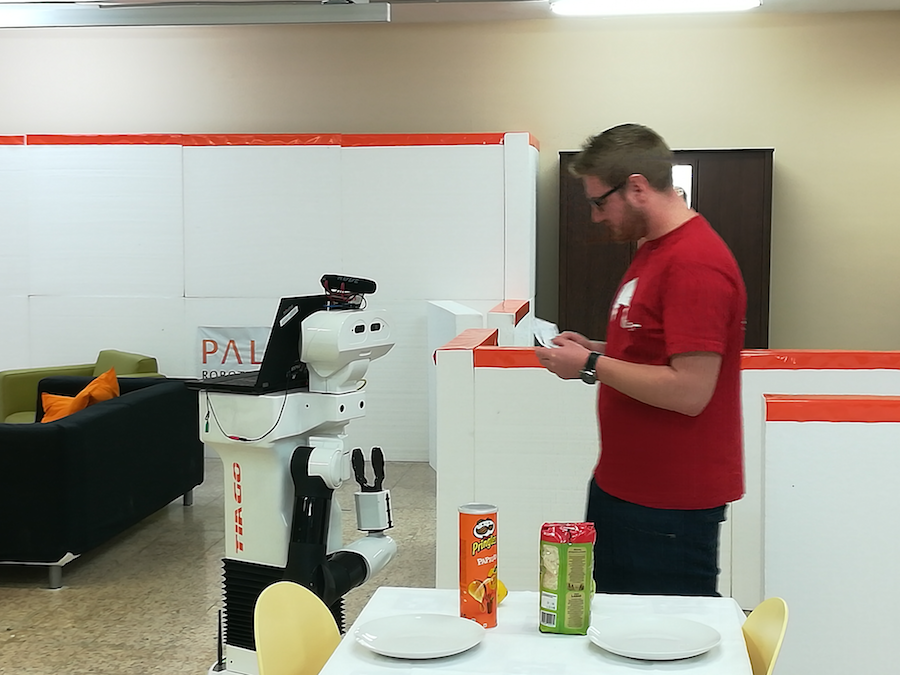
Robohub.org
European Robotics Week 2017: Live coverage
 We hope you’re enjoying the European Robotics Week! If you’re still looking for events to attend over the weekend, make sure to check out the map of 1000 happenings all over Europe.
We hope you’re enjoying the European Robotics Week! If you’re still looking for events to attend over the weekend, make sure to check out the map of 1000 happenings all over Europe.
One highlight was the European Robotics League competition focused on service robotics with teams from Spain, Germany, the United Kingdom and Portugal. The teams had to show how their robots can assist old people in their daily life, all in an attrezzo that simulates a home.
The central event of the week was held in Brussels, and featured a “Robots Discovery” exhibition hosted by the European Committee of the Regions, where robotics experts from 30 European and regionally-funded projects outlined how their work could impact society. Exhibiting projects are listed below.
- EurEyeCase will design instrumenation and control techniques to improve clinical outcome for a selection of relevant and urgent eye surgery procedures for certain pathologic conditions, affecting over 16 million elderly persons worldwide.
- MURAB has the ambition to drastically improve precision and effectiveness of the biopsy gathering for cancer diagnostic operations. Through a robotic device which can autonomously scan the target area and optimally acquire data, the use of expensive Magnetic Resonance Imaging (MRI) will be reduced to a minimum.
- SoftPro project will study and design soft synergy-based robotics technologies to develop new prostheses, exoskeletons, and assistive devices for upper limb rehabilitation, which will greatly enhance the efficacy and accessibility for a greater number of users. SoftHand Pro: a prosthetic hand that is robust, versatile, usable, strong, and delicate.
- IoT and robotic technologies are two complementary domains with large potential for improving our daily life quality. The two showcased projects are: imec.WONDER, where a Nao robot engages in personalized interactions with people suffering from dementia, tracking behavioral disturbances by means of environmental sensors; and imec.ROBOCURE, where social robots are interfacing with networked glucose meters for improved diabetes education and follow-up therapy at home.
- BabyRobot’s ambition is to create robots that can establish communication protocols, form collaboration plans on the fly, and create an impact beyond the consumer and healthcare application markets. BabyRobot focuses on special education for children with autism.
- The Vrije Universiteit Brussel is involved with many different robotics initiatives ranging from local projects (Brubotics/VUB Exoskeleton), spinoffs (Axiles), and international collaborations (CYBERLEGs). These projects are focused on assistive technologies and human-robot interactions, developing new exoskeleton technologies, commercializing new prosthetic devices such as the Axiles ankle prosthesis, and developing new powered prosthetic devices to assist those who may not be able to use current designs.
- Early diagnosis with a non-invasive and painless endoscopic technique to eradicate colorectal cancer? Yes, a new solutions exists: the Endoo medical platform. The Endoo European Project aims to develop an active colonoscopic platform for robotic guidance of a painless, innovative, smart, and soft-tethered device, in order to achieve accurate and reliable diagnosis and therapy of colonic pathologies, with high acceptance by patients for preventive mass screening.
- The Educational Robotics for STEM (ER4STEM) project aims to turn curious children into young adults passionate about science and technology through a hands-on platform using robotics The project’s research is aimed at developing an open operational and conceptual framework that involves pedagogical methods as well as technologies and tools for educational robotics, including a web repository of educational robotics in Europe.
- The European Robotics League (ERL), a novel model for competitions funded by the European Commission, brings a common framework for three robotics challenges: ERL Industrial Robots, ERL Service Robots and ERL Emergency Robots, allowing teams to test their robots’ ability to face real-world situations. The ERL local and major tournaments are based in Europe and are open to international participation. European cities can apply to host an ERL tournament.
- LUVMI is a small, lightweight rover being designed to explore polar regions of the Moon and drive into a Permanently Shadowed Region (PSR), believed to hold vast stores of water. Instruments carried by the rover will look specifically for this water which may be potentially game-changing for future manned missions to the moon.
- Makeathons and hackathons are excellent tools to foster collaborations and co-creation in a world of complex and disruptive solutions. To connect the possibilities and the need for robots and artificial intelligence between companies, startups and academic groups, the InQbet makeathon takes place simultaneously in Brussels, New York and Singapore. More than 100 attended the kick-off, and 50 experts members are developing solutions with startups.
- Using robotics to teach children about programming and other digital skills, improves motivation, makes programming tangible and naturally links together different topics in science and engineering. Dwengo has developed several tools and teaching materials to be used during classroom activities. Moreover, international projects such as WeGoSTEM and Udavi brought robot education to socio-disadvantaged children worldwide!
- In the IDLab at UGent – imec has developed multiple quadruped robots over the past decade. By building and programming quadruped robots, one can really understand the underlying principles of movement and cognition.
- Asbestos materials were used in many installations, flats, and offices in the past. Even though their hazardous effects to the human health are well known, the material is still present in many buildings. The Bots2ReC Project aims at the development of a robotic system for the efficient automated removal of asbestos contamination, without putting human workers at risk.
- The CoCoRo project aimed at creating a swarm of interacting, cognitive, autonomous robots. The swarm of autonomous underwater vehicles (AUVs) are able to interact with each other in order to achieve environmental monitoring, search and exploration of underwater habitats.
- DexROV develops technologies for executing sub-sea dexterous interventions (maintenance of infrastructures, geology, biology, archaeology…) with underwater robots (ROVs) from a remote control center, through a satellite communication link. The remote control center is featured with a double arm, and double hands allowing the pilot to instruct dexterous operations. DexROV will be demonstrated in 2018 at 1,000 meters deep in the Mediterranean sea, while being operated from Zaventem, in Belgium.
- The BADGER autonomous underground robotic system will be able to drill, maneuver, localise, map and navigate in the underground space, and will be equipped with tools for constructing horizontal and vertical networks of stable bores and pipelines. The proposed robotic system will operate in domains of high societal and economic impact including trenchless constructions, cabling and pipe installations, geotechnical investigations, large-scale irrigation installations, search and rescue operations, remote science and exploration applications.
- SAGA is an ECHORD++ experiment. The goal of the project is to prove the applicability of swarm robotics to precision farming.
- The ICARUS project proposes a comprehensive and integrated set of unmanned search and rescue tools which consist of assistive unmanned air, ground, and sea vehicles, equipped with victim-detection sensors. The unmanned vehicles collaborate as a coordinated team, communicating via ad hoc cognitive radio networking.
- The H2020-SafeShore project, has as a main goal to cover existing gaps in coastal border surveillance, increasing internal security by preventing cross-border crime such as trafficking in human beings and the smuggling of drugs. It is designed to be integrated with existing systems and create a continuous detection line along the border.
- The TIRAMISU project aims at providing the foundation for a global toolbox that will cover the main mine action activities, from the survey of large areas to the actual disposal of explosive hazards, including mine risk education and training tools.
- The goal of SHERPA is to develop a mixed ground and aerial robotic platform to support search and rescue activities in a real-world hostile environment like the alpine scenario.
- Disaster response and other tasks in dangerous and dirty environments can put human operators at risk. The ECHORD++ HyQ-REAL experiment will bring to the real world IIT’s four-legged robot, capable of a wide repertoire of indoor/outdoor motions ranging from running and jumping to carefully walking over rough terrain.
- Co4Robots is a European-wide collaboration between industry and academia that aims to build a systemic, integrated methodology with which to accomplish complex tasks given to a group of robots in various environments such as a hotel, an office, a hospital, or a warehouse.
For more news, follow #ERW2017 on twitter or below.
#ERW2017 Tweets



